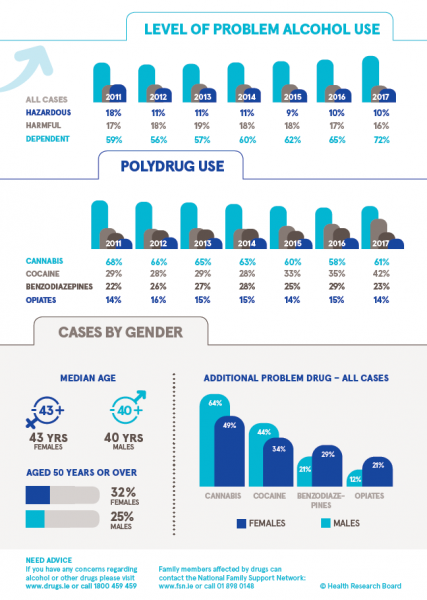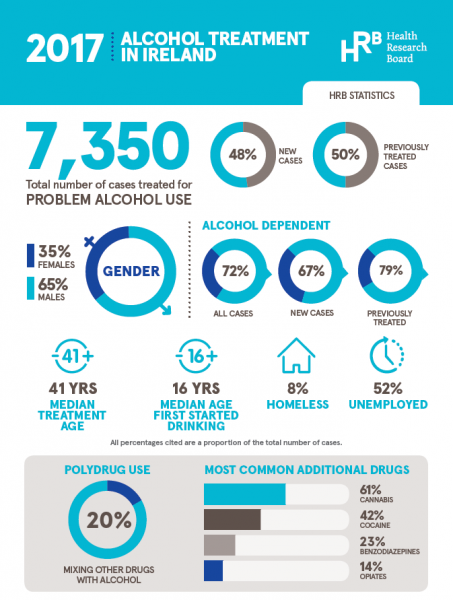Health Research Board. (2019) Alcohol treatment in Ireland 2011 – 2017. Dublin: Health Research Board.
| Preview | Title | Contact |
|---|---|---|
|
PDF (Alcohol treatment in Ireland 2011 – 2017)
740kB | |
|
PDF (Alcohol treatment in Ireland 2011 – 2017 - Press release)
- Supplemental Material
443kB |
Latest alcohol treatment figures from the Health Research Board (HRB) show 55,675 cases* were treated for problem alcohol use in Ireland between 2011 and 2017. There were 7,350 treated cases during 2017, a decrease from 7,643 in 2016.
- Three-in-every four cases were alcohol dependent.
- Women have similar rates of alcohol dependence to men.
- Polydrug use affects one in five cases presenting for treatment.
Key findings
Between 2011 and 2017, 55,675 cases were treated for problem alcohol use.
- The number of cases decreased to 7,350 in 2017 from a high of 8,876 in 2011.
- The proportion of new cases decreased from 52% in 2011 to 48% in 2017.
- One-in-five cases treated had problem use of more than one drug, and cannabis was the most common additional drug along with alcohol.
Level of problem alcohol use
- In 2017, the median age at which cases first started drinking was 16 years, similar to previous years.
- Almost three-quarters (72%) of all cases were alcohol dependent**.
- The proportion of previously treated cases who were alcohol dependent increased from 68% in 2011 to 79% in 2017.
- In 2017, 74% of males were alcohol dependent, compared to 68% of females.
Socio-demographics
- The median age of treated cases was 41 years.
- Almost two thirds of cases were male (65%).
- Cases recorded as Irish Traveller in ethnicity represented 1.6% of all cases.
- Over half (52%) of cases were unemployed.
- The proportion of cases that were homeless increased from 6% in 2011 to 8% in 2017.
- In 2017, a higher proportion of males (10%,) were homeless compared to females (5%).
- Almost one-third (32%) of females were aged 50 and over compared to one-quarter (25%) of males.
Polydrug use
Polydrug use (problem use of more than one drug) - remained relatively stable in the period 2011 (19%) to 2017 (20%) accounting for one-fifth of those treated for problem alcohol use.
- Cannabis was the most common additional drug used. The number of cases reported declined steadily from 68% in 2011 to 58% in 2016 but increased slightly to 61% in 2017.
- Cocaine was the second most common additional drug recorded. This has increased from 29% in 2011 to 42% in 2017.
- In 2017, cocaine as an additional drug was more common among males (44%) than females (34%).
- Benzodiazepines were the third most common additional drug reported (23%). The proportion reporting benzodiazepines as an additional problem increased from 22% in 2011 to 29% in 2016, and then decreased to 23% in 2017.
- In 2017, opiates as an additional drug are more common among females (21%) than males (12%).
Gender comparison
- Median age of treated cases was higher for females (43 years) than males (40 years). This is reflected in the median age for new cases entering treatment (38 for males and 43 for females)
- A higher proportion of females were aged 50 years or over (32%female, 25%male).
- Cannabis is the most common additional drug for both males and females
- Benzodiazepines (29% females, 21% males) and opiates (21% females, 12% males) are reported at a higher rate by females than males.
- Homelessness was more prevalent among males (10%) than females (5%).

Repository Staff Only: item control page
